Home
 Compost
Compost
WIRE MESH COMPOST BINS
Wire mesh composting bins are versatile, inexpensive and easy to construct.
They may be used as holding bins for composting moderate amounts of yard
wastes or as turning systems for quick composting of larger volumes.
Holding bins are a convenient way of composting yard wastes with little
effort: Simply add wastes as they are cleaned up from the yard. With no
effort besides occasional moistening compost will be ready in 6 months
to 2 years. Attention to chopping materials, maintaining moisture by
watering and covering piles with plastic, and occasional turning will
produce compost in less time. The bin can be easily moved to turn piles
or to harvest finished compost: Just undo latches, pull the mesh away from
compost and set it up elsewhere. The pile may then be turned into the bin
at its new location and compost can be removed from the bottom.
The circular and panel designs illustrated each have advantages.
The circle bin may be made for under $10 from poultry wire or hardware cloth.
Poultry wire is the least expensive material, however it quickly loses
its shape with use, requiring support with posts and frequent replacement.
For a slightly higher cost, hardware cloth creates a self supporting circle
which is easier to manipulate and more durable. A panel unit offers a
greater variety of uses. Panels may be added to enlarge the bin or create
small bins for turning piles, and individual panels may be used for
screening coarse materials from finished compost. A sturdy and attractive
panel bin can be made with l6 gauge plastic coated wire mesh for under $20.
Materials:
Circle Bin (3-½ foot diameter)
12-½ feet of 36" wide 1" poultry wire, or
½" hardware cloth, or
16 guage plastic coated wire mesh.
4 metal or plastic clips, or copper wire ties.
3-4 four foot wooden or metal posts
for poutry wire bins.
|
Five-Panel Bin
15 feet of 24" wide 12 to 16 guage
plastic coated wire mesh, or
½" hardware cloth.
20 metal or plastic clips, or
plastic coated copper wire ties.
|
TOOLS: Heavy duty wire or tin snips, pliers, hammer or metal file, work gloves.
Construction Details:
Circle Bin -
Roll out and cut 12-½ feet of poultry wire, hardware cloth or plastic
coated wire mesh. If using poultry wire, roll back three to
four inches at each end of cut piece to provide a strong clean edge
which will be easy to latch and won’t poke or snag. Set wire
circle in place for compost pile and secure ends with clips or wire ties.
Space wood or metal posts around perimeter inside wire circle.
Pound posts firmly into the ground while tensing them against wire to
provide support.
If using hardware cloth, trim ends flush with a cross wire
to eliminate loose edges that may poke or scratch hands. Apply file
to each wire along cut edge to ensure safer handling when opening and
closing bins. Bend hardware cloth into circle and attach ends with
clips or ties. Set bin in place for composting. Bins made with hardware
cloth should be strong enough to stand alone without posts.
Plastic coated wire mesh bins are made in the same manner,
except that bending this heavier material into an even circular shape
will require extra effort. Also, filing the wire ends may cause the
plastic coating to tear. Striking the end of each wire with a hammer
a few times will knock down any jagged edges.
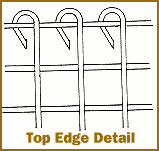 Five-Panel Bin -
Five-Panel Bin -
Cut five three-foot long sections of 24" wide wire mesh.
Make cuts through middle of squares to leave ½" long wires
sticking out along both cut edges. Choose a top and bottom for
each panel, then use a pliers to bend over and tightly clamp each
wire on the top edge. This provides protection against scraping
arms when adding yard wastes to the bin. Wires along the bottom
edge are left sticking out to grip the ground and provide rigidity
to the bin. Striking the end of each wire with a hammer will clean
up any jagged edges. Attach panels using clips or wire ties.
PORTABLE WOOD & WIRE COMPOSTING BIN
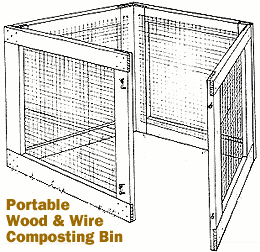 This portable bin provides a convenient way to compost moderate
volumes of yard wastes with minimal labor. Yard wastes are
simply added to the bin as they are generated. With no effort
besides occasional moistening, compost will be ready in 6 months
to 2 years. Chopping or shredding materials, maintaining adequate
moisture by watering and covering with plastic or heavy fabric,
and occasional turning will produce finished compost in a
shorter period of time. Texture of the finished compost
depends on the materials composted and how long they are
left in the bin. Mixing fresh greens with brown yard wastes
will produce the best results.
This portable bin provides a convenient way to compost moderate
volumes of yard wastes with minimal labor. Yard wastes are
simply added to the bin as they are generated. With no effort
besides occasional moistening, compost will be ready in 6 months
to 2 years. Chopping or shredding materials, maintaining adequate
moisture by watering and covering with plastic or heavy fabric,
and occasional turning will produce finished compost in a
shorter period of time. Texture of the finished compost
depends on the materials composted and how long they are
left in the bin. Mixing fresh greens with brown yard wastes
will produce the best results.
This bin is very flexible. It fits well in small spaces,
and may be used either as a yard waste holding bin or as a
portable turning unit. The bin can be easily moved to turn
piles or to harvest finished compost and build a new pile:
Simply undo the latches, pull the sides apart and move it.
Compost may then be turned into the bin at its new location,
and finished compost can be removed from the bottom. It costs
around $50 to build using new materials, less if recycled
materials are used.
Materials:
1 12 foot pressure treated 2×4
3 12 footfir 2×4
12 feet of 36" wide ½" hardware cloth
100 1-½" galvanized No. 8 wood screws
4 3" galvanized butt door hinges
150 poultry wire staples or power stapler
1 10 oz. tube exterior wood adhesive
6 large hook and eye gate latches
|
Tools:
Hand saw and chisel, or radial
arm saw with dado blade, or circular
saw, or table saw. Hammer, screwdriver,
tin snip, caulking gun, pencil and small
carpenter's square.
Use eye and ear protection.
|
Construction Details:
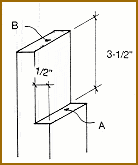 Cut each 12 foot 2×4 into four 3 foot long pieces.
Cut a ¾" deep and 3-½" wide section out of each end, for
a total of 32 lap cuts. If using handsaw and chisel, cut 3/4"
down at the 3-½ inch line, at A in diagram to right. Then cut a
½" deep groove into the end of the board, at B in the diagram.
Place a thick wood chisel in the end groove and split the wood with
a hammer to the 3-½ " cut. If using a radial arm saw, circular
saw or table saw, set blade depth to ¾" and make multiple
passes until the whole section is removed.
Cut each 12 foot 2×4 into four 3 foot long pieces.
Cut a ¾" deep and 3-½" wide section out of each end, for
a total of 32 lap cuts. If using handsaw and chisel, cut 3/4"
down at the 3-½ inch line, at A in diagram to right. Then cut a
½" deep groove into the end of the board, at B in the diagram.
Place a thick wood chisel in the end groove and split the wood with
a hammer to the 3-½ " cut. If using a radial arm saw, circular
saw or table saw, set blade depth to ¾" and make multiple
passes until the whole section is removed.
Make four 3 foot square frames from the lap jointed 2×4s.
Use one pressure treated 2×4 on each frame. Put enough construction
adhesive to fill the gaps when the lap joints are screwed together.
Fasten each joint with four screws.
Cut the hardware cloth with tin snips into four 3 foot
square sections. Bend the edges of the cloth back over 1"
for strength. Lay one onto each of the four frames. Center
and tack each corner with a poultry wire staple. Hammer
place a staple every 4" along all four edges of the
hardware cloth. Try to tension the cloth so it will not
sag when filled with compost.
Connect each pair of frames together with two hinges.
Then put the hook and eye gate latches on the other ends
so that the sections latch together.
WOOD & WIRE STATIONARY 3-BIN SYSTEM
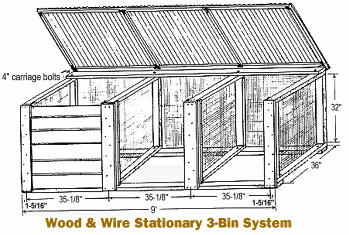 This system is used to compost large amounts of yard and
kitchen wastes in a brief period of time. Wastes are stored
until enough are available to fill an entire bin.
Materials are then chopped, moistened and layered to ensure
a hot compost. Piles are turned weekly for aeration.
A pile made with a balance of fresh greens and woody
materials and turned weekly can be ready to use in three weeks.
The texture of the finished compost depends on the materials composted.
This unit can be built for approximately $130. Construction
requires basic carpentry skills and tools.
This system is used to compost large amounts of yard and
kitchen wastes in a brief period of time. Wastes are stored
until enough are available to fill an entire bin.
Materials are then chopped, moistened and layered to ensure
a hot compost. Piles are turned weekly for aeration.
A pile made with a balance of fresh greens and woody
materials and turned weekly can be ready to use in three weeks.
The texture of the finished compost depends on the materials composted.
This unit can be built for approximately $130. Construction
requires basic carpentry skills and tools.
Materials:
2 18 toot treated 2×4s
4 12 foot, or 8 6 foot treated 2×4s
1 9 foot and 2 6 foot 2×2s
1 16 foot cedar 2×6
9 6 foot cedar 1×6s
22 feet of 36" wide ½" hardware cloth
12 ½" carriage bolts 4" long
12 washers and 12 nuts for bolts
3 lbs. of 16d galvanized nails
½ lb. Bd galvanized casement nails
250 poultry wire staples or power stapler w/ 1" staples
1 12 foot and 1 - 8 foot sheet 4oz. clear corrugated fiberglass
3 8 foot len ths of wiggle molding
40 gasketed aluminum nails
for corrugated fiberglass roofing
2 3" zinc plated hinges for lid
8 flat 4" corner braces with screws
4 flat 3" T-braces with screws
|
Tools:
Hand saw or circular power saw,
drill with ½" and 1/8" bits,
screwdriver, hammer, tin snips,
tape measure, pencil, ¾" socket
or open ended wrench, carpenters square,
(option - power stapler with 1" long
galvanized staples), safety glasses
and ear protection.
|
|
|
 Subscribe to Garden Notes
Subscribe to Garden Notes
 and we will inform you of new articles as they are posted!
and we will inform you of new articles as they are posted!
|


|
Construction Details:
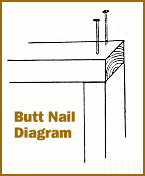 Build Dividers -
Build Dividers -
Cut two 31-½" and two 36" pieces . from each 12 foot 2×4.
Butt end nail the four pieces into a 35" × 36" square.
Repeat for other three sections. Cut four 37" long sections
of hardware cloth, bend back edges 1". Stretch hardware
cloth across each frame, check for squareness of the frame and
staple screen tightly into place every 4" around edge.
Set up Dividers-
Set up dividers parallel to one another 3 feet apart.
Measure and mark centers for the two inside dividers.
Cut four 9 foot pieces out of the two 18 foot 2×4 boards.
Place two 9 foot base boards on top of dividers and measure
the positions for the two inside dividers. Mark a center
line for each divider on the 9 foot 2×4. With each divider
line up the center lines and make the base board flush
against the outer edge of the divider. Drill a ½"
hole through each junction centered l' in from the inside edge.
Secure base boards with carriage bolts, but do not tighten yet.
Turn the unit right side up and repeat the process for the
top 9 foot board. Using the carpenters square or measuring
between opposing corners, make sure the bin is square, and
tighten all bolts securely. Fasten a 9 foot long piece of
hardware cloth securely to the back side of the bin with
staples every 4" around the frame.
Front Slats and Runners -
Cut four 36" long 2×6s for front slat runners.
Rip cut two of these boards to 4-¾" wide and nail
them securely to the front of the outside dividers and
baseboard, making them flush on top and outside edges.
Save remainder of rip cut for use as back runners.
Center the remaining full width boards on the front
of the inside dividers flush with the top edge, and
nail securely. To create back runners, cut the remaining
2×6 into a 34" long piece and then rip cut into 4
equal pieces, 1-¼"×2". Nail back runner parallel
to front runners on side of divider leaving a 1" gap
for slats. Cut all the 1×6" cedar boards into slats
31-¼" long.
Fiberglass Lid -
Use the last 9 foot 2×4 for the back of the lid. Cut four 32-½ inch 2×2s and
one 9 foot 2×2. Lay out into position on ground as illustrated on front page
and check for squareness. Screw in corner braces and T-braces on bottom side
of the frame. Center lid frame, brace side down on bin structure and attach
with hinges. Cut wiggle board to fit the front and back 9 foot sections
of the lid frame. Predrill wiggle board with 1/8" drill bit and nail
with 8d casement nails. Cut fiberglass to fit flush with front and back edges.
Overlay pieces at least one channel wide. Predrill fiberglass and wiggle
board for each nail hole. Nail on top of every third hump with gasketed nails.
|










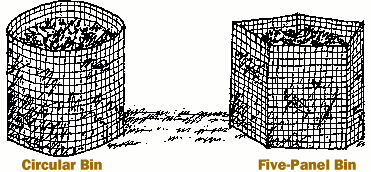
 This portable bin provides a convenient way to compost moderate
volumes of yard wastes with minimal labor. Yard wastes are
simply added to the bin as they are generated. With no effort
besides occasional moistening, compost will be ready in 6 months
to 2 years. Chopping or shredding materials, maintaining adequate
moisture by watering and covering with plastic or heavy fabric,
and occasional turning will produce finished compost in a
shorter period of time. Texture of the finished compost
depends on the materials composted and how long they are
left in the bin. Mixing fresh greens with brown yard wastes
will produce the best results.
This portable bin provides a convenient way to compost moderate
volumes of yard wastes with minimal labor. Yard wastes are
simply added to the bin as they are generated. With no effort
besides occasional moistening, compost will be ready in 6 months
to 2 years. Chopping or shredding materials, maintaining adequate
moisture by watering and covering with plastic or heavy fabric,
and occasional turning will produce finished compost in a
shorter period of time. Texture of the finished compost
depends on the materials composted and how long they are
left in the bin. Mixing fresh greens with brown yard wastes
will produce the best results. Cut each 12 foot 2×4 into four 3 foot long pieces.
Cut a ¾" deep and 3-½" wide section out of each end, for
a total of 32 lap cuts. If using handsaw and chisel, cut 3/4"
down at the 3-½ inch line, at A in diagram to right. Then cut a
½" deep groove into the end of the board, at B in the diagram.
Place a thick wood chisel in the end groove and split the wood with
a hammer to the 3-½ " cut. If using a radial arm saw, circular
saw or table saw, set blade depth to ¾" and make multiple
passes until the whole section is removed.
Cut each 12 foot 2×4 into four 3 foot long pieces.
Cut a ¾" deep and 3-½" wide section out of each end, for
a total of 32 lap cuts. If using handsaw and chisel, cut 3/4"
down at the 3-½ inch line, at A in diagram to right. Then cut a
½" deep groove into the end of the board, at B in the diagram.
Place a thick wood chisel in the end groove and split the wood with
a hammer to the 3-½ " cut. If using a radial arm saw, circular
saw or table saw, set blade depth to ¾" and make multiple
passes until the whole section is removed. This system is used to compost large amounts of yard and
kitchen wastes in a brief period of time. Wastes are stored
until enough are available to fill an entire bin.
Materials are then chopped, moistened and layered to ensure
a hot compost. Piles are turned weekly for aeration.
A pile made with a balance of fresh greens and woody
materials and turned weekly can be ready to use in three weeks.
The texture of the finished compost depends on the materials composted.
This unit can be built for approximately $130. Construction
requires basic carpentry skills and tools.
This system is used to compost large amounts of yard and
kitchen wastes in a brief period of time. Wastes are stored
until enough are available to fill an entire bin.
Materials are then chopped, moistened and layered to ensure
a hot compost. Piles are turned weekly for aeration.
A pile made with a balance of fresh greens and woody
materials and turned weekly can be ready to use in three weeks.
The texture of the finished compost depends on the materials composted.
This unit can be built for approximately $130. Construction
requires basic carpentry skills and tools. Build Dividers -
Build Dividers -


 Five-Panel Bin -
Five-Panel Bin -